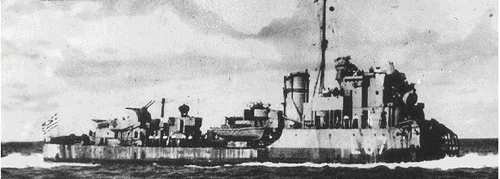- Articles Index
- Monthly Features
- General History Articles
- Ancient Near East
- Classical Europe and Mediterranean
- East Asia
- Steppes & Central Asia
- South and SE Asia
- Medieval Europe
- Medieval Iran & Islamic Middle East
- African History (-1750)
- Pre-Columbian Americas
- Early Modern Era
- 19'th Century (1789-1914)
- 20'th Century
- 21'st Century
- Total Quiz Archive
- Access Account
The Destroyer that wouldn't Sink
By Giannis
Category: 20th Century: Military History
One of the most distinguished warship of the Greek fleet during WWII was the Hunt class escort destroyer, ''ADRIAN''.
The formerly known destroyer ''HMS BORDER'' of the British Royal Navy was transferred in the Greek Navy in 1942. Records suggest that on January 27th, 1943, she sank the German U-boat U533 near Cape Finisterre, and, on February 13th of the same year, she sank or severely damaged the U-boat U633. During her service, ''ADRIAS'' escorted many convoys around the Mediterranean sea and also participated in the landings of Sicily, where she engaged three Italian torpedo-boats. She sank two of them and put the third one out of action. On September 10, 1943, the Italain fleet, based at Taranto, surrendered to a force of the Allied Fleet. ''ADRIAS'' was one of the consisted four destroyers, the other three were British. The reason that ''ADRIAS'' became famous was her epic last voyage. On the night of October 24th, 1943, along with the ''HMS Huworth'', it set off for a position south of Leros island in the Aegean sea, to create a diversion to protect ships landing stores for the British troops. On their way, they ran into a newly laid minefield and the ''ADRIAS'' was the first to be hit. The explosion cut off the vessel's prow and blew the two-gun forward turret over the bridge. The ''HURWORTH'', in her effort to assist the ''ADRIAS'', hit a mine and immediately sank with a loss of 143 men. The ''ADRIAS'' tried to rescue survivors. Among the rescued was her Commanding Officer. By some very skillful seamanship, the captain and his crew managed to beach the remains of the ship, at the port of Gioumoutlzouk, with losses of 21 dead and 30 wounded.
With the crew working relentlessly, the ship was made seaworthy, and, on December 1st, 1943, she started her return trip to Alexandria (Egypt). In daylight, she laid hidden under camouflage nets in Turkish territorial waters. The Germans were reluctant to bomb in case they gave offense to the Turks, but she finally reached Cyprus where she refueled, and, on December 4th, 1943, she started for Aexandria at approximately 8 knots under her own steam. Entering the harbour, all allied warships cleared the lower decks and cheered her in.
Her Greek C.O., Commander Toumbos, was awarded the Greek equivalent of the Victorian Cross and a message was send to Swan Hunters paying tribute to the performance of the ship, when so badly damaged. The ''ADRIAS'' was broken up in Gateshead in 1945.
|





